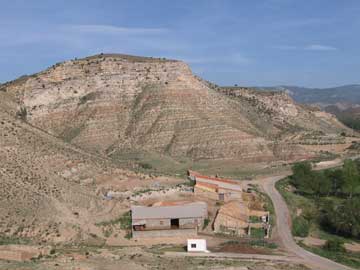|
News Notes
Paleontology
Wobbling Earth linked to mammal extinctions
 Periodic changes in Earth’s orbit and tilt may be controlling the appearances and disappearances of mammal species, a new study suggests. The study lends support to one side of a long-standing debate over whether climate change or the interaction between species is the leading driver for mammalian evolution.
Periodic changes in Earth’s orbit and tilt may be controlling the appearances and disappearances of mammal species, a new study suggests. The study lends support to one side of a long-standing debate over whether climate change or the interaction between species is the leading driver for mammalian evolution.
Rodent teeth found in 10.2- to 8.9-million-year-old rocks in northern Spain, shown here, reveal patterns in mammal species’ appearances and disappearances that a recent study ties to changes in Earth’s orbit and tilt. Photograph is by Hemmo Abels.
Climatologists have long been aware that Earth’s alternating glacial and interglacial periods are connected to changes in how Earth moves around the sun. About every 100,000 years, Earth’s orbit varies in its elliptical path, altering its overall distance from the sun. The planet also periodically changes how sharply it is tilted on its axis and how much it “wobbles” about its axis like a gyroscope, in cycles of about 41,000 years and 23,000 years, respectively. The orbit, tilt and wobble can change how much solar radiation Earth’s Northern and Southern hemispheres receive, influencing the advance and retreat of glaciers and together comprising the climatic cycles known as Milankovitch cycles. More recently, scientists have identified much longer cycles, of 1.2 and 2.4 million years.
Those cycles have never been directly linked to mammalian extinctions, however. Instead, scientists have posited that interactions among different species, such as competition for habitats or predation, were the primary factors driving the appearances and disappearances of mammal groups. “This has been a bit of a controversy in the world of mammalian evolution,” says Anthony Barnosky, a paleoecologist at the University of California in Berkeley. “Does climate drive the major patterns in the history of mammals, or is it interactions between species?” he says.
Like climate cycles, the origination and eventual extinction of mammal species follow a periodic pattern, says Jan van Dam, a paleobiologist at Utrecht University in the Netherlands. To pin down that pattern, van Dam and his colleagues sifted through rodent fossils buried in a layered sequence of rocks in Spain that spanned 22 million years, from the late Oligocene (24.5 million years ago) to the Pliocene (2.5 million years ago). The team collected more than 80,000 rodent molars, which are easy to distinguish at the species level, van Dam says, and identified 132 evolutionary lineages.
Using the frequencies of the molars’ abundances in specific rock layers, the team found that appearances and disappearances of mammal species “were not distributed randomly across the timescale — there were peaks, or pulses, of events,” van Dam says. Many species originated or went extinct roughly every 2.4 million to 2.5 million years, he says. A smaller peak occurred every 1 million years.
Comparing those peaks with the Milankovitch cycles, the team observed that the larger extinction peaks correlated with periods in the 2.4-million-year cycle when Earth’s orbit was most circular. The smaller, 1-million-year peaks correlated to the times when Earth’s axis was most sharply tilted, suggesting that both Earth’s orbit and tilt play a role in driving mammalian evolution, the team reported in the Oct. 12 Nature.
Having such a long, thorough dataset to correlate with the orbital variations has been key, says Barnosky, who was not involved in the study. Previous studies of how climate affects species evolution have tended to focus on a particular group, or on a small part of the timescale, but “this is really the first study that has had the kind of record that is needed to examine it on Milankovitch-cycle timescales,” he says. “It does point out a very logical trigger for the mammalian turnover that we see.”
Other researchers, however, question whether van Dam’s team’s data are sufficient to determine that climate is driving mammalian change through time. “The conclusions are extremely speculative,” says John Alroy, a research biologist at the National Center for Ecological Analysis and Synthesis in Santa Barbara, Calif. An earlier study published by Alroy in 2000 found no correlation between climate change and mammal species patterns, with the fossil data spanning “the entire Cenozoic,” from 65 million years ago to present, Alroy says.
Additional long-term datasets of mammal fossils from other locations, including North America, South America and Asia, might help move the debate forward, Barnosky says. Van Dam agrees, saying that “these patterns should be checked in other groups, both terrestrial and marine.”
Data from marine microfossils suggest that they follow a similar pattern of fluctuations in their abundance, van Dam says. “But these were not analyzed at the species level, in terms of their extinctions and originations, so there’s still a lot of work to be done.”
Carolyn Gramling

 Subscribe
Subscribe

